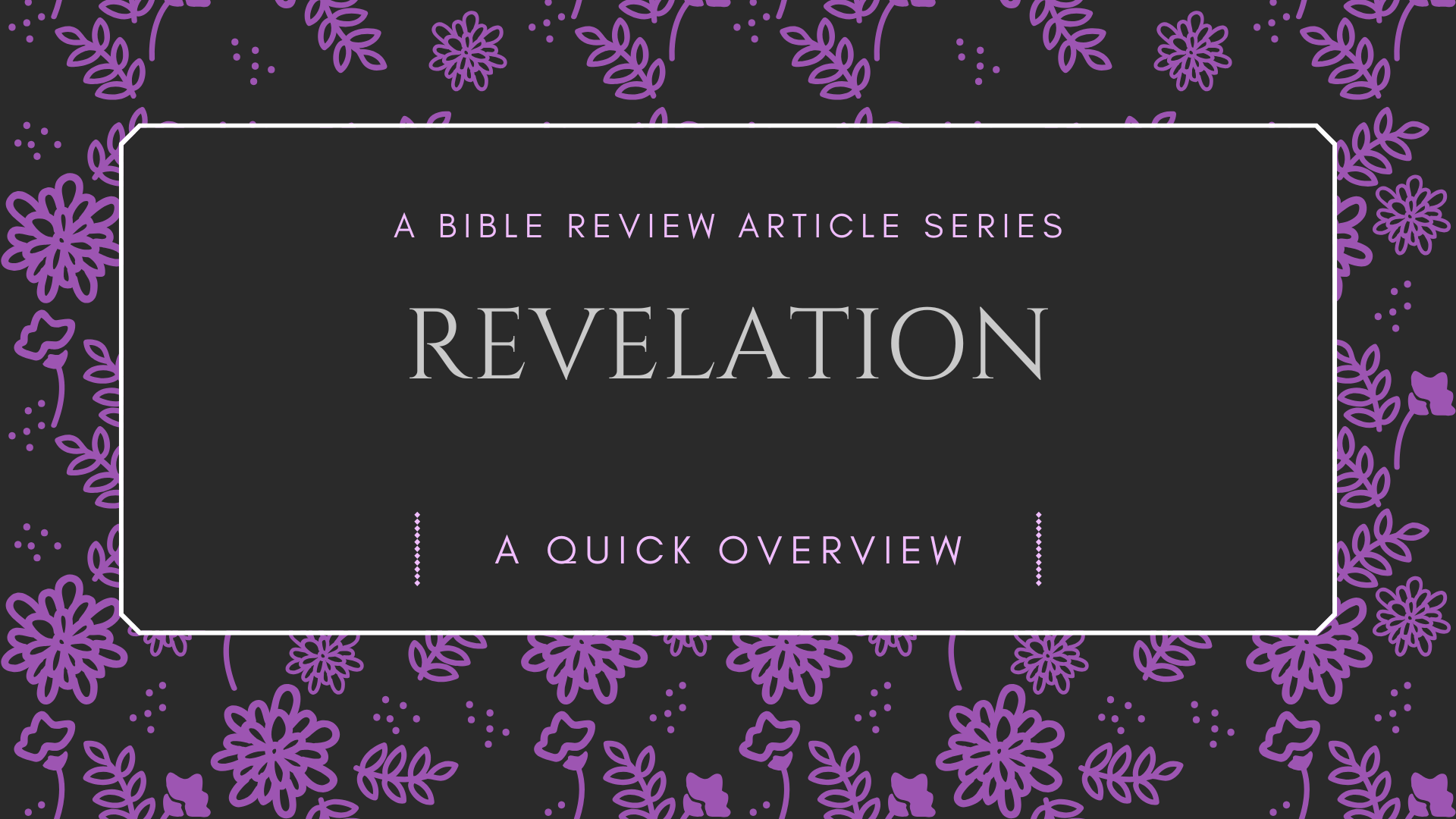
Revelation: A Quick Overview
by Milo





Follow us on social media for
FREEBIES and New Article releases.
OR
Sign Up for Our Freebie Email List and Have Freebies Delivered Directly To Your Inbox
Introduction
The Book of Revelation is the final book of the Bible and presents a powerful vision of Jesus Christ's ultimate victory over evil. It contains prophecy, encouragement, warnings, and a vivid depiction of end-time events.
Authorship and Date
Traditionally attributed to the Apostle John, Revelation was written around AD 95 while John was exiled on the island of Patmos.
Purpose and Themes
Revelation was written to encourage believers to remain faithful amid persecution and trials, offering hope by revealing God’s final victory over evil. Major themes include:
- Christ’s Sovereignty: Jesus is the victorious King.
- Judgment and Justice: God's righteous judgment against sin.
- Perseverance: Encouragement for Christians to endure.
- Worship: Heavenly scenes of praise and glory to God.
- New Creation: The promise of a new heaven and new earth.
Key Verses
- Revelation 1:8 – “I am the Alpha and the Omega... who is, and who was, and who is to come...”
- Revelation 3:20 – “Here I am! I stand at the door and knock...”
- Revelation 12:11 – “They triumphed over him by the blood of the Lamb...”
- Revelation 21:4 – “He will wipe every tear from their eyes...”
- Revelation 22:20 – “Yes, I am coming soon.”
Summary of Content
The book opens with letters to seven churches, followed by prophetic visions involving seals, trumpets, bowls of wrath, beasts, the fall of Babylon, the return of Christ, the final judgment, and the establishment of the New Jerusalem.
Structure of Revelation
- Chapters 1–3: Letters to the Seven Churches
- Chapters 4–5: Heavenly worship and the throne room
- Chapters 6–11: Seals and trumpets
- Chapters 12–14: Conflict between good and evil
- Chapters 15–16: Seven bowls of God’s wrath
- Chapters 17–19: Fall of Babylon and Christ’s return
- Chapter 20: The Millennium and final judgment
- Chapters 21–22: New heaven, new earth, and eternal life
Notable Characters and Symbols
- Jesus Christ: The Lamb, King of kings, and Judge
- John: The apostle who received the visions
- The Seven Churches: Represent real churches and church types
- The Beast and False Prophet: Symbols of worldly power and deception
- The Dragon: Symbolic of Satan
- The 144,000: A sealed group of faithful servants
- The Two Witnesses: Prophets with power and testimony
- Babylon: Symbol of corrupt world systems
- The New Jerusalem: The eternal home of the redeemed
Application and Relevance
Revelation reminds believers of the reality of spiritual warfare and the certainty of Christ’s return. It calls Christians to endure, worship faithfully, and live in hope of God’s promised future. Despite intense symbolism, the central message is clear: Jesus wins, and those in Him share in that victory.
Connections to Other Books
Revelation ties together prophetic themes from Daniel, Ezekiel, Isaiah, and Zechariah. It completes the story of redemption begun in Genesis and fulfilled in the Gospels. It is the final fulfillment of the promises made throughout Scripture.
Study Questions
- What are the main messages given to the seven churches?
- What do the scroll and seals represent in Revelation 5–6?
- How do the trumpets and bowls display God’s judgment?
- What spiritual battles are described in Revelation 12?
- What is the significance of Babylon’s fall?
- How is Jesus described in His return in Revelation 19?
- What does the millennium mean in Revelation 20?
- What happens at the Great White Throne Judgment?
- What are the features of the New Jerusalem?
- How does Revelation end and what is the final invitation?
FAQs and Common Questions
- Who wrote Revelation?
The Apostle John.
- What is the main purpose of Revelation?
To reveal Christ's ultimate victory and encourage believers.
- Is Revelation meant to be taken literally?
It contains symbolic language and visions, often interpreted in multiple ways.
- What are the seven churches?
Early Christian churches in Asia Minor (modern-day Turkey).
- What is the mark of the beast?
A debated symbol of allegiance to the antichrist or worldly powers (Revelation 13).
- What does the number 666 mean?
Associated with the beast; often interpreted symbolically or numerologically.
- What is the New Jerusalem?
The eternal, holy city prepared for God’s people.
- Is Revelation about the end of the world?
It is about the end of this age and the beginning of eternity with God.
- How does Revelation encourage believers?
It promises Christ’s return, justice, and eternal life for the faithful.
- What role does worship play in Revelation?
Worship is central, with many heavenly scenes of praise.
Daily Reading Plan
| Day |
Reading |
| Day 1 | Revelation 1–2 |
| Day 2 | Revelation 3–4 |
| Day 3 | Revelation 5–6 |
| Day 4 | Revelation 7–9 |
| Day 5 | Revelation 10–12 |
| Day 6 | Revelation 13–16 |
| Day 7 | Revelation 17–19 |
| Day 8 | Revelation 20–22 |
More Bible Overviews
Genesis Overview
Exodus Overview
Proverbs Overview
Ecclesiastes Overview
Isaiah Overview
Daniel Overview
Matthew Overview
Gospel of John Overview
Acts Overview
Romans Overview
1 Corinthians Overview
Revelation Overview
Freebie Offers
Sign Up for Our Freebie Email List and Have Freebies Delivered Directly To Your Inbox

Recommended Reading
Feeding Your Spiritual Growth: Best Online Bible Study Platforms
Strengthen Your Spirit: Impactful Bible Study Topics for Believers
Find Your Voice: Expressive Church Journal Prompts for Christians
Journey to Enlightenment: Best Bible Study Tools for Growth
From Busyness to Fruitfulness: A Biblical Approach to Time Management (Part 1)
From Busyness to Fruitfulness: Biblical Strategies for Effective Time Use (Part 2)
SOAP Bible Study and Other Study Methods: Which One is Right for You?
How to Use the SOAP Bible Study Method for a Deeper Walk of Faith
How to Study the Psalms Using the SOAP Method
Applying Biblical Wisdom to Financial Decision-Making
Visit Us on Pinterest









